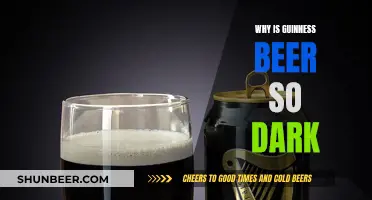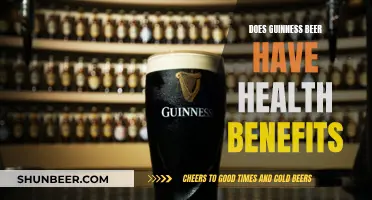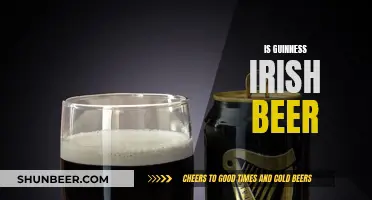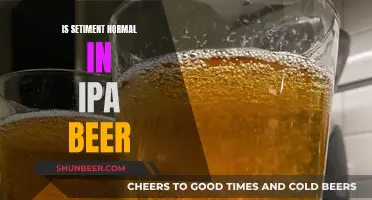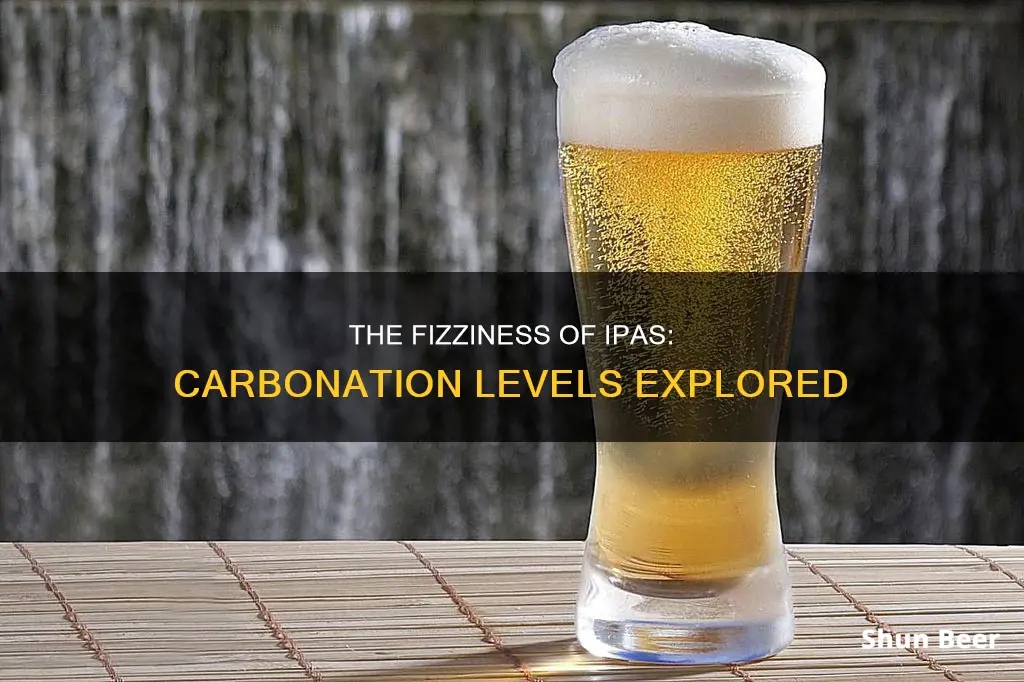
India Pale Ale, or IPA, is a popular beer style that originated in Britain during colonial times. IPAs are known for their hoppy quality and range of styles, from the traditional West Coast IPA to the trendy New England IPA. While some IPAs are bitter, others explore fruity flavors, and the level of carbonation can vary depending on the style and brewer's preference. Some IPAs, like the West Coast variety, are known for their higher carbonation, while New England IPAs are often fermented to have lower carbonation. Brewers experiment with different carbonation levels to find the perfect balance between bitterness, aroma, and mouthfeel, as carbonation can enhance these characteristics. Ultimately, the carbonation level of an IPA can vary depending on the brewer's style and the desired outcome, contributing to the diverse and evolving nature of this beloved beer style.
Are IPA Beers Carbonated?
| Characteristics | Values |
|---|---|
| Carbonation | Variable, with some IPAs having lower carbonation than others |
| Examples of carbonation levels | 2.2-2.65 |
| Effect of carbonation | Higher carbonation can improve mouthfeel, head retention, bitterness, and aroma |
| New England IPAs | Tend to have lower carbonation |
| West Coast IPAs | Tend to have higher carbonation |
What You'll Learn

New England IPAs have lower carbonation
India Pale Ales (IPAs) are a popular style of beer that comes in a range of styles. One of the most popular IPAs is the New England IPA, also known as the Hazy IPA. These beers are characterised by their unfiltered, hazy appearance and extremely low bitterness, often achieved through dry-hopping. In addition to their unique appearance and flavour profile, New England IPAs also tend to have lower carbonation than other styles of IPAs.
Carbonation is the process of adding carbon dioxide to a beverage, which gives it a fizzy or sparkling quality. While carbonation can improve the taste and mouthfeel of a beer, some brewers choose to lower the carbonation level in their New England IPAs to achieve a specific set of characteristics.
Lowering the carbonation level in a New England IPA can enhance the creaminess and mouthfeel of the beer, creating a softer and fuller drinking experience. This can be particularly desirable for New England IPAs, as they often have a thicker mouthfeel than other styles of beer. By reducing the carbonation, brewers can emphasise the creaminess and minimise the prickly sensation of carbonation on the palate.
Additionally, lowering the carbonation can also reduce the bitterness of the beer. New England IPAs are known for their low bitterness, so brewers may choose to lower the carbonation to further enhance this characteristic. While higher carbonation can emphasise hop aromatics, it can also increase the perception of bitterness. By lowering the carbonation, brewers can strike a balance between emphasising the hop aromatics and maintaining the low bitterness that New England IPAs are known for.
Achieving the desired carbonation level in a New England IPA can be a delicate process. Brewers may need to experiment with different carbonation levels to find the perfect balance for their specific beer. Some brewers suggest targeting a carbonation level of around 2.2 to 2.6 volumes for New England IPAs, which is slightly lower than the carbonation level of a typical IPA.
In conclusion, New England IPAs are known for their lower carbonation, which is a deliberate choice by brewers to enhance the creaminess, mouthfeel, and low bitterness that characterise this style of beer. By adjusting the carbonation level, brewers can create a unique drinking experience that showcases the complex flavours and aromas of New England IPAs.
Guinness Beer vs. World Records: What's the Difference?
You may want to see also

West Coast IPAs are highly carbonated
The style of West Coast IPAs can be traced back to two different California breweries. The first is San Francisco's Anchor Brewing, where Fritz Maytag crafted an English-style pale ale using American hops in 1975, known as Liberty Ale. The second influential brewery is Sierra Nevada, founded by Ken Grossman, which created the iconic Sierra Nevada Pale Ale in 1980. This beer, brewed with Cascade hops, initiated the trend of piney bitter beers that continues to be popular.
West Coast IPAs showcase a range of hoppy, citrus-forward, and earthy fruit aromas and flavours. They are often loaded with tropical fruit, citrus, and pine notes, creating a complex and flavourful drinking experience. The higher carbonation in this style of IPA enhances the crisp and clean characteristics, making them particularly refreshing.
While West Coast IPAs are known for their bold and assertive flavours, they also offer a well-balanced drinking experience. The higher carbonation levels contribute to a lighter and more effervescent mouthfeel, providing a pleasant contrast to the strong flavours. This balance between flavour and mouthfeel is part of the reason for the enduring popularity of West Coast IPAs.
Some popular examples of West Coast IPAs include the Stone IPA, Bear Republic Racer 5, Sierra Nevada Torpedo, and Ballast Point Sculpin. These beers showcase the diverse and complex flavours that can be achieved within this style, with a range of hop varieties and malt profiles contributing to their unique characteristics.
Guinness Beer: The Magic of Nitrogen and Carbon Dioxide
You may want to see also

Brut IPAs are meant to be fizzy
India Pale Ales (IPAs) come in a range of styles, and not all IPAs are bitter or have a high alcohol content. One such style is the Brut IPA, which is meant to be highly carbonated and fizzy.
Brut IPAs are a modern craft beer style that originated in 2017 at the now-closed Social Kitchen & Brewery in San Francisco. They were created as a West Coast reaction to the rising trend of East Coast hazy and juicy IPAs, as well as thick and sweet milkshake IPAs. The style is still evolving, and most versions seem to be morphing into low-calorie IPAs.
Brut IPAs are characterised by their very pale colour, ranging from very pale straw to very light gold, and their high to very high carbonation, which gives them a massive, rocky, billowy, white head with tight, persistent bubbles. They have a restrained bitterness level and a bone-dry finish, with a light, clean alcohol note. The hop character is modern, emphasising flavour and aroma dimensions, with a wide range of possible characteristics such as tropical, stone fruit, citrusy, or white grape. The malt character is subtle, neutral, and in the background, ensuring that the hops take centre stage.
To achieve the desired level of carbonation, Brut IPAs are often force carbonated in a keg or bottle-conditioned. Force carbonation involves storing the beer cold in a sealed container under CO2 pressure, allowing the CO2 to dissolve into the beer over time. For bottle conditioning, brewers need to know the amount of residual CO2 in the flat beer and the amount of priming sugar required to add the desired level of carbonation. German hefeweizen bottles are a great choice for packaging highly carbonated Brut IPAs, and brewers should aim for a carbonation level of 3.5-4.0 volumes of CO2, which is noticeably higher than the average craft beer or lager.
Guinness Beer Widget: What's Its Purpose?
You may want to see also

Higher carbonation can improve the taste and mouthfeel
India Pale Ales (IPAs) are a broad style of beer, and not all IPAs are bitter or have a high alcohol content. The modern approach to hoppy beer is to explore the world of fruity flavors that can also come from hops.
IPAs are often carbonated, and higher carbonation can improve the taste and mouthfeel. Carbonation can enhance certain flavors, such as sourness and saltiness, and inhibit others. The tingling sensation associated with carbonated drinks is highly sought after and contributes to the mouthfeel and enjoyment of beverages. The presence of bubbles can also modulate the carbonation perception, with higher localized concentrations of carbon dioxide resulting in a heightened sensation.
Carbonation can also mask mouthfeel differences, as seen in the case of diet and regular colas. However, too low or too high carbonation results in an overall imbalance of flavors. The formation and growth of carbon dioxide bubbles can have a considerable effect on flavor release and taste perception.
The carbon dioxide in carbonated drinks is converted into protons by an enzyme, which are detected by sour-sensing cells as a sour taste. This sourness is one of the elements of the process of tasting carbonated drinks.
The Oldest Beer: Guinness's Historical Journey
You may want to see also

Different levels of carbonation can be achieved through various methods
India Pale Ales (IPAs) are a broad style of beer, and not all IPAs are bitter or have a high alcohol content. IPAs come in a range of styles, including session IPAs, double or imperial IPAs, dry-hopped IPAs, triple dry-hopped IPAs, single-hopped IPAs, fresh-hopped or harvest ales, West Coast IPAs, New England IPAs, East Coast IPAs, oat IPAs, lactose or milkshake IPAs, Belgian IPAs, fruited IPAs, sour IPAs, and Brett IPAs.
One method to achieve carbonation is forced carbonation, which involves cooling the beer and applying pressure. This is commonly done with kegs, where the desired carbonation level can be achieved by adjusting the pressure and temperature. For example, to reach an average carbonation level of 2.5 volumes, a keg can be kept at a temperature of 45 °F (7 °C) with a pressure of 15 psi of CO2.
Another method is bottle conditioning, which involves creating carbonation through a small amount of fermentation in the bottle. This is done by fermenting the beer completely until it is flat, priming it with a small amount of sugar, bottling it, and then waiting a couple of weeks for the fermentation to take place. The amount of priming sugar added will affect the level of carbonation, and calculators are available to help brewers dial in the desired volume of CO2.
The level of carbonation can also be influenced by factors such as agitation, headspace in the bottle, and the method of measurement for the priming sugar. Additionally, the type of sugar used for priming can impact the carbonation level, as different sugars have varying levels of fermentability.
The High Price of Guinness Beer: Is It Worth It?
You may want to see also
Frequently asked questions
Yes, but the level of carbonation varies depending on the type of IPA and the brewer.
The average level of carbonation for an ordinary craft beer or standard lager is 2.4–2.6 volumes of CO2. However, IPAs can have carbonation levels as high as 2.6 or even higher.
The level of carbonation in an IPA can depend on the style of the beer, the desired mouthfeel, and the method of carbonation. For example, New England-style IPAs tend to have lower carbonation, while West Coast IPAs are known for their higher carbonation. Brewers might also adjust the carbonation level based on feedback from consumers, with some preferring a more lively carbonation and others opting for a more tame option.


